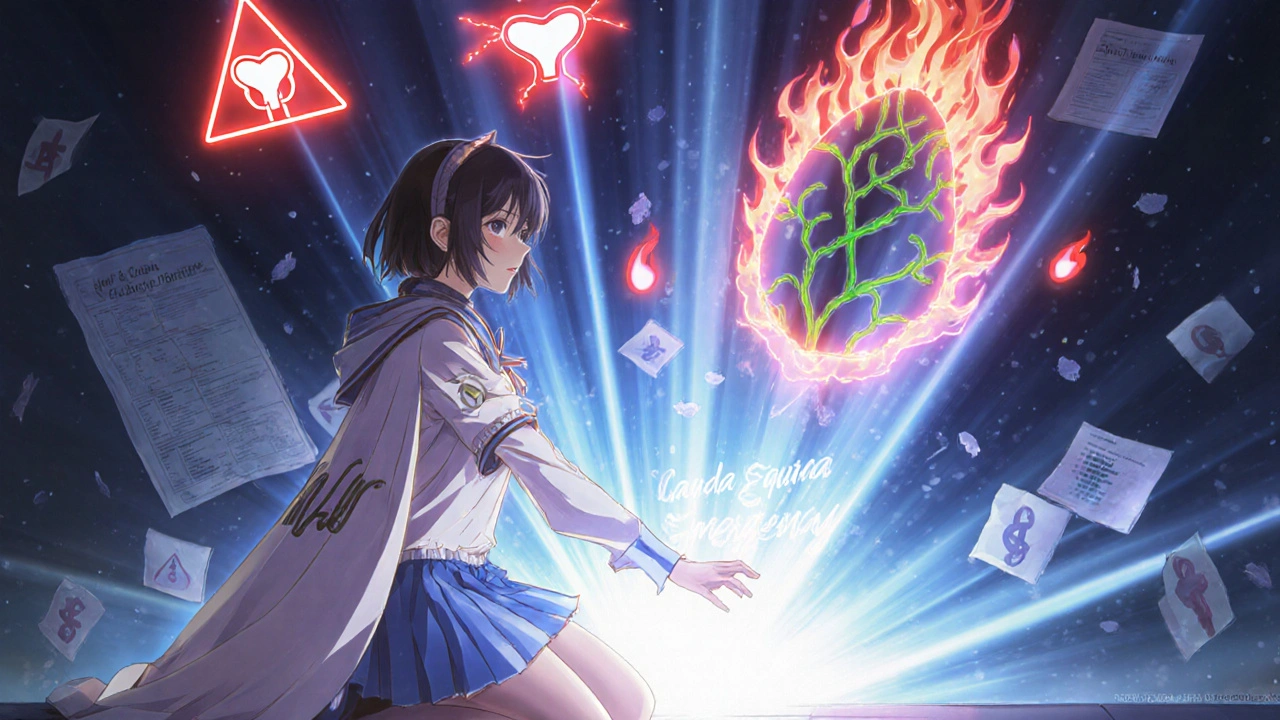 Nov, 23 2025
Nov, 23 2025
Most people will experience low back pain at least once in their life. It’s not rare-it’s normal. But here’s the problem: low back pain is often treated like an emergency when it’s almost never one. Around 97% of cases are simple mechanical pain-no tumor, no fracture, no nerve damage. Just strained muscles, stiff joints, or irritated nerves from movement, posture, or stress. The real danger isn’t the pain itself. It’s what happens when we panic, order scans too soon, or skip the one thing that actually fixes it: movement.
What Are Red Flags, and Why Do They Matter?
Red flags aren’t signs you should ignore. They’re warning lights that something serious might be going on. But they’re not triggers for an MRI. They’re triggers for a deeper conversation-with your doctor, not your phone’s search bar. There are four main red flag categories: cancer, fracture, infection, and cauda equina syndrome. These are rare. Together, they make up only 1-2% of all low back pain cases. But missing one can cost you mobility, bladder control, or even your life. Here’s what to watch for:- History of cancer-especially if you’ve had breast, lung, prostate, or kidney cancer. New back pain in someone with a past cancer diagnosis raises red flags.
- Unintentional weight loss-losing 10 pounds or more in 3-6 months without trying, especially with pain that gets worse at night.
- Major trauma-a car crash, fall from height, or direct blow to the back. Even if you feel okay at first, internal damage can show up later.
- Pain at night or while resting-if your pain wakes you up or doesn’t improve with rest, it’s not just a pulled muscle. It could be infection or tumor.
- Fever or chills-especially with tenderness when you tap on your spine. This could mean a spinal infection.
- Bladder or bowel problems-incontinence, inability to urinate, or loss of control. This is a medical emergency. Don’t wait. Don’t call your primary care doctor first. Go to the ER.
- Saddle anesthesia-numbness in your inner thighs, buttocks, or around your genitals. It feels like you’re sitting on a saddle. This is a classic sign of cauda equina syndrome.
- Loss of anal sphincter tone-this is something a doctor checks during an exam. You won’t feel it yourself, but if you have other red flags, this one confirms the risk.
Here’s the catch: most of these red flags are weak on their own. A 65-year-old with back pain? Age alone isn’t a red flag. A 45-year-old with mild pain that’s worse at night? Not enough. You need combinations. If you have cancer history and weight loss and night pain, that’s a different story. That’s when you need imaging-fast.
When Should You Get an X-Ray, MRI, or CT Scan?
Let’s be clear: if you have no red flags, imaging is not just unnecessary-it’s harmful. Why? Because scans find things that aren’t problems. A 50-year-old with back pain will almost always have disc degeneration on an MRI. That’s normal aging. But if you’re told you have a “herniated disc,” you might start avoiding movement, fearing damage. That leads to weakness, fear, and more pain. It’s a trap. Major guidelines from the American College of Radiology, the American College of Physicians, and the Canadian Family Physicians Association all agree:- Acute low back pain (under 4 weeks) with no red flags? No imaging needed. Period.
- Subacute or chronic pain (over 4 weeks) without red flags? X-rays aren’t helpful. MRIs aren’t helpful. You’re better off with exercise and time.
- Red flags present? Then MRI without contrast is the gold standard. It shows nerves, tumors, infections, and spinal cord issues better than anything else.
- Suspected infection? Bone scan with SPECT/CT or contrast-enhanced CT may be needed.
- Suspected fracture? CT scan gives the clearest view of bone damage.
Here’s what doesn’t work: ordering X-rays for “arthritis” or “spinal alignment.” Most X-rays of the lower back show nothing useful. They miss soft tissue injuries, nerve compression, and early tumors. They expose you to radiation. And they cost hundreds-sometimes thousands-of dollars.
One study found that 42.7% of doctors still order X-rays for acute back pain without red flags. That’s not just outdated-it’s wasteful. In the U.S. alone, unnecessary imaging for back pain costs $3 billion a year. That’s money that could go to physical therapy, better pain education, or community health programs.

Exercise Therapy: The Only Treatment That Works Long-Term
If you’ve been told to rest, avoid bending, or wear a back brace, you’ve been misled. The best evidence we have-over 97 randomized trials with nearly 20,000 people-shows that exercise therapy is the most effective treatment for non-specific low back pain. Not pills. Not injections. Not braces. Exercise. The Cochrane Review found that people who did regular exercise had:- 6.64 points less pain on a 100-point scale after 6-12 months
- 6.69 points better function
That’s not a small change. That’s a meaningful improvement-better than most painkillers, and without side effects.
But not all exercise is the same. Here’s what works best:
- Motor control exercises-these teach you to activate deep core muscles (like the transverse abdominis) without overworking your outer muscles. Think pelvic tilts, dead bugs, and bird-dogs. Effect size: 0.61.
- Graded activity-you start with gentle movement and slowly increase intensity. This is great for people scared of pain. It rewires the brain to stop seeing movement as dangerous. Effect size: 0.52.
- Combined programs-mix of strengthening, aerobic activity, and flexibility. Walking, swimming, cycling, and light resistance training. Effect size: 0.58.
Here’s the practical plan:
- Start with 2-3 sessions per week, supervised by a physical therapist or certified trainer.
- Focus on form, not speed or weight. Pain should never go above 3/10 during exercise.
- After 4-6 weeks, transition to a home program. Do it 3-5 times a week.
- Include aerobic activity: 20-30 minutes of brisk walking or cycling, 3 times a week.
- Progress strength training gradually: start at 40-60% of your max lift, build to 70-85% over 8-12 weeks.
Adherence is everything. If you stop after 4 weeks, you get no long-term benefit. The magic happens after 8-12 weeks. That’s when your body adapts. Your nerves calm down. Your brain stops overprotecting your back.
Why So Many Doctors Get It Wrong
You’d think guidelines are clear. They are. But doctors are rushed. A typical back pain visit lasts 12.7 minutes. The recommended time? 18-22 minutes. In that short window, it’s easier to order an X-ray than to explain why it’s not needed. It’s easier to say “take ibuprofen” than to teach someone how to move safely. And patients? They want a quick fix. A scan. A pill. A cure. Worse, many doctors still believe age over 50 is a red flag. It’s not. A 60-year-old with back pain has no higher risk of cancer or fracture than a 35-year-old-with the same symptoms. That’s a myth. And it leads to unnecessary scans. A 2022 survey found 68.3% of primary care doctors incorrectly thought age over 50 meant imaging was needed. That’s not just wrong-it’s dangerous. It normalizes fear.
What You Can Do Right Now
If you have low back pain:- Don’t panic. Most cases get better in 4-6 weeks on their own.
- Don’t stop moving. Walk. Stretch. Move your hips. Even if it’s uncomfortable.
- Check for red flags. If you have any of the serious signs-bladder issues, fever, unexplained weight loss-go to the ER.
- Ask your doctor: “Is this a red flag case? Do I need imaging?” If they say yes, ask why.
- Ask for a referral to physical therapy. Most insurance covers it. Most doctors don’t offer it.
- Start a simple home routine: 10 minutes of walking, 5 minutes of pelvic tilts, 5 minutes of cat-cow stretches. Do it daily.
Low back pain isn’t a disease. It’s a signal. It’s telling you your body needs more movement, better load management, or less stress. It’s not broken. It’s just out of practice.
The real solution isn’t in a scan. It’s in your body. And it’s been there all along.
Is low back pain always serious?
No. Over 97% of low back pain cases are not serious. They’re caused by muscle strain, joint stiffness, or nerve irritation from movement or posture. These types of pain usually improve within 4 to 6 weeks with movement and time. Only 1-2% of cases involve serious conditions like cancer, infection, or spinal cord compression.
Should I get an MRI if my back hurts?
Only if you have red flags like bladder or bowel problems, unexplained weight loss, fever, or a history of cancer. For most people with simple back pain, MRI scans show normal aging changes that aren’t causing pain. Getting one early can lead to unnecessary worry, treatments, or even surgery for problems that would have resolved on their own.
Can exercise make back pain worse?
Only if you do it too fast or with poor form. Gentle movement-like walking, swimming, or stretching-is safe and helps. Avoid high-impact activities or heavy lifting until you’ve built strength. Pain during exercise should stay mild (under 3/10). If pain shoots down your leg or gets worse over days, stop and see a professional.
Is bed rest helpful for low back pain?
No. Bed rest makes back pain worse over time. Studies show that staying active-even with mild discomfort-leads to faster recovery. Lying down for more than a day or two can cause muscle weakness, stiffness, and increased fear of movement. Move within your limits. Even short walks help.
What’s the best exercise for low back pain?
There’s no single “best” exercise, but motor control exercises (like pelvic tilts and dead bugs), graded activity (gradually increasing movement), and combined programs (walking + strength + stretching) have the strongest evidence. The key is consistency-doing something regularly for 8-12 weeks. Walking 20-30 minutes a day is a great starting point for most people.
When should I go to the ER for back pain?
Go to the ER immediately if you have: loss of bladder or bowel control, sudden numbness in your groin or inner thighs, weakness in both legs, or severe pain after a fall or accident. These could be signs of cauda equina syndrome or spinal fracture-conditions that need urgent treatment to prevent permanent damage.
james lucas
November 24, 2025 AT 02:05man i used to be the guy who’d lay on the couch for a week if my back twinged, thought i was gonna need surgery or somethin. then i started just walkin. like, 10 mins a day. no fancy stuff. just walkin. and after a month? the pain just… faded. not gone, but like it stopped yellin at me. i still do it every day. even on days i feel fine. its weird how simple it is, but yeah, movement is the real MVP. no scan needed, no pills, just legs movin.
Michael Fitzpatrick
November 25, 2025 AT 01:46really appreciate this breakdown. so many docs just hand you a script and a shrug. i had an MRI last year after a ‘bad’ lift and they found ‘degeneration’-which, turns out, is just what happens when you’re 42. my PT laughed and said ‘congrats, you’re human.’ now i do bird-dogs every morning like a ritual. no pain, no fear. just movement. the system’s broken, but your body? it’s way smarter than the algorithm that pushed that scan on you.
Danny Nicholls
November 25, 2025 AT 15:00omg YES to the motor control stuff 🙌 i used to think core = six packs, but nooo. it’s about the deep stuff-transverse abdominis, pelvic floor, all that quiet muscle jazz. i started with dead bugs on the floor, barely moved, and now i can do squats without my back screaming. it took 3 months. patience is the secret sauce. also, if your doc says ‘age 50+ = scan!’ run. that’s outdated nonsense. my 68-yo grandma walks 2 miles daily and has zero pain. her spine? looks like a 30-year-old’s on MRI. just moved right. 💪
Robin Johnson
November 27, 2025 AT 12:52you don’t need a scan. you need a plan. and most people don’t get one because the system doesn’t reward education-it rewards quick fixes. i’m a PT. i’ve seen people cry because they were told their disc was ‘herniated’ and now they’re terrified to bend over. guess what? their disc wasn’t the problem. their fear was. start walking. move gently. build tolerance. your nervous system will thank you. and no, you don’t need a $1200 MRI to prove you’re not broken. you just need to trust your body again.
Rahul Kanakarajan
November 28, 2025 AT 16:49why do people still believe this? exercise doesn’t fix everything. i had back pain for 3 years. did yoga, Pilates, dead bugs, everything. still hurt. turned out i had a tumor. scans saved me. so don’t be a dumbass and ignore symptoms. if it doesn’t get better in 2 weeks, get checked. your ‘movement’ theory is nice, but it’s not science-it’s a prayer.
New Yorkers
November 30, 2025 AT 12:42we live in a world where the body is a machine to be fixed, not a story to be heard. we scan because we fear the unknown. we prescribe pills because we don’t have time to sit with pain. but pain? it’s not noise. it’s a whisper from your soul saying ‘you’ve been ignoring me.’ the real crisis isn’t back pain-it’s the collective amnesia of what it means to be human in a world that wants you numb.
David Cunningham
December 1, 2025 AT 10:00aye mate, i’ve been doing this for years. back pain? i just go for a swim. ocean’s free, and the saltwater’s like magic. no scans, no meds. just me, the waves, and my stubborn spine. even on cold days, i’m in. 20 mins, 3 times a week. i’m 58, and i still hike with my grandkids. movement ain’t a cure-it’s a lifestyle. and yeah, i’ve seen too many Aussies get scammed into MRIs for ‘wear and tear.’ it’s just aging. not a diagnosis.
luke young
December 1, 2025 AT 23:20biggest thing i learned? pain isn’t always damage. sometimes it’s just your body being loud because it’s been asleep. i used to think if it hurt, i was hurting myself. now i know: if it’s under 3/10 and moves with me, it’s just talking. i started with 5 minutes of walking every morning. now i’m doing kettlebells. no injury. no fear. just progress. thanks for reminding me that healing doesn’t need a machine-it needs patience.
Jessica Correa
December 3, 2025 AT 18:24i used to think rest was healing but now i know movement is the medicine. i do pelvic tilts while brushing my teeth. just 10 reps. no big deal. but over time? it changed everything. i don’t even think about my back anymore. weird how small things add up. also, if your doctor pushes an xray for back pain without red flags, ask them if they’ve read the guidelines. most haven’t. and that’s sad.
manish chaturvedi
December 4, 2025 AT 04:42as someone from India where back pain is often dismissed as ‘just tiredness,’ this article is a breath of fresh air. we have a culture of enduring pain without seeking proper care. but the truth is, movement is universal. whether you’re in Mumbai or Milwaukee, your spine responds to gentle motion. i teach my students to walk daily, stretch their hips, and avoid sitting for more than 30 minutes. no scans. no drugs. just awareness. the body remembers what the mind forgets.